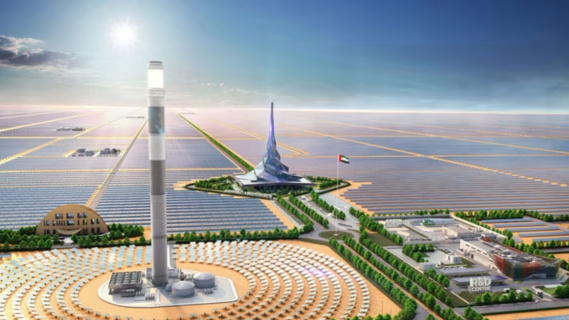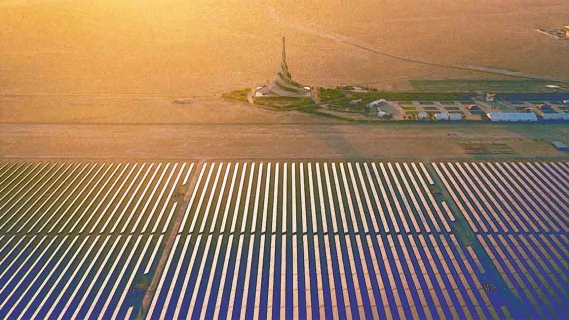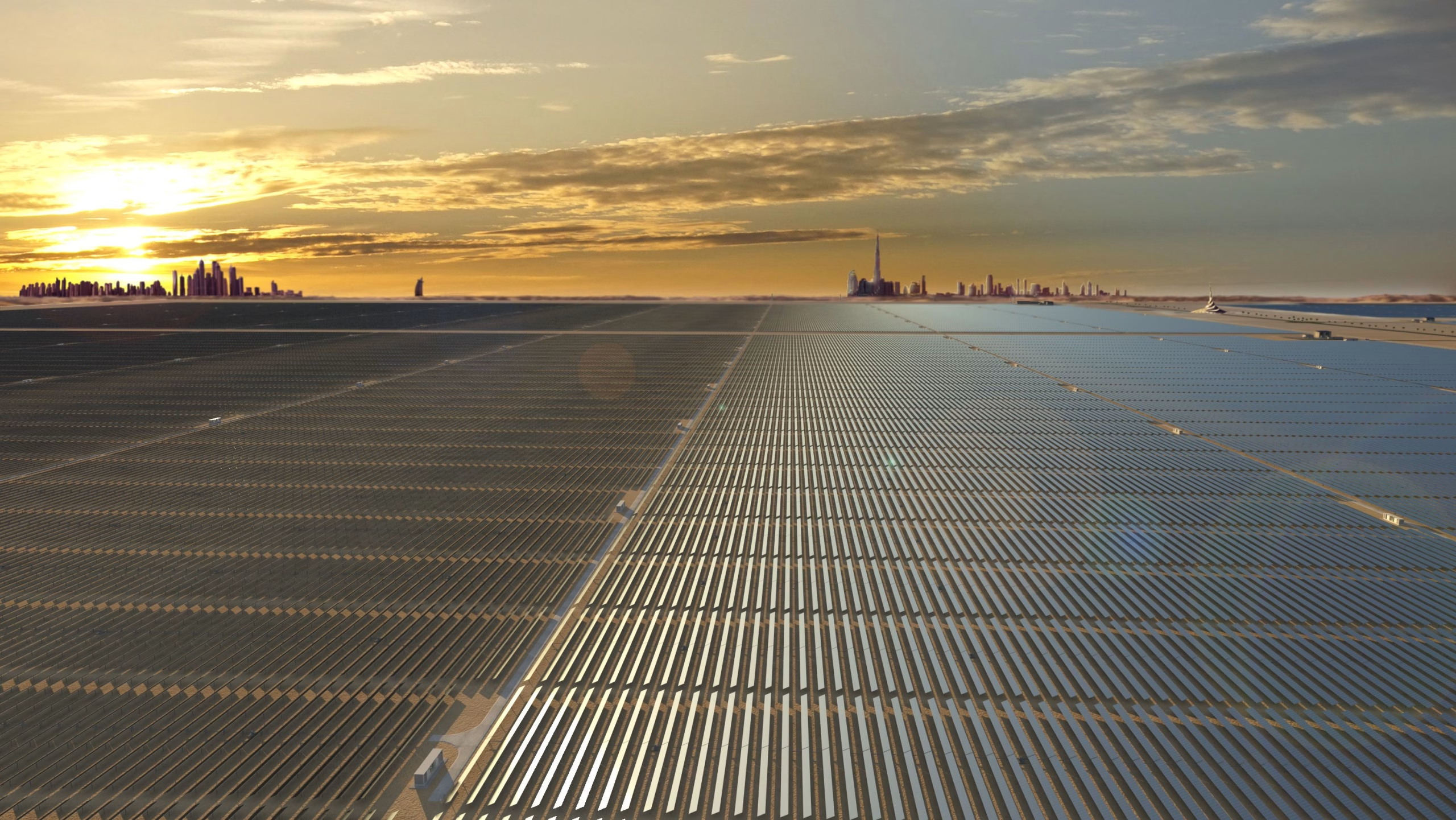Updated November 5, 2025: Dubai Electricity and Water Authority (DEWA) has invited qualified companies and consortiums to submit proposals for the 7th phase of the Mohammed bin Rashid Al Maktoum Solar Park. This phase will add 2,000 megawatts (MW) from photovoltaic solar panels and include a 1,400MW battery storage system with a six-hour capacity. Furthermore, it will provide a total storage capacity of 8,400 megawatt-hours. This makes it one of the world’s largest solar-plus-storage projects. The project supports the Dubai Clean Energy Strategy 2050 and the Dubai Net Zero Carbon Emissions Strategy 2050.
The ambitions aim to provide 100 percent of the emirate’s total power capacity from clean sources by mid-century. To date, DEWA has received 49 expressions of interest (EOIs) requesting the Request for Qualification document for the seventh phase. The EOI document was released on 16th May 2025 and the Request for Proposal document was issued to qualified bidders on 20th October 2025. Saeed Mohammed Al Tayer, MD and CEO of DEWA, emphasised that this pioneering project aligns with the vision of His Highness Sheikh Mohammed bin Rashid Al Maktoum. The 7th phase of the Mohammed bin Rashid Al Maktoum solar park is one of many energy projects in the UAE such as the construction of Masdar’s $6 Billion Solar-Battery Project, the world’s first gigawatt-scale renewable energy project. The project is expected to deliver continuous, round-the-clock power. The renewable energy development combines a 5.2 GW solar plant with a 19 GWh battery energy storage system.
October 24, 2025: The Mohammed bin Rashid Al Maktoum Solar Park, located in Dubai, UAE, is a pivotal project in the global clean energy transition and is set to be the world’s largest single-site solar park upon completion. Developed by the Dubai Electricity and Water Authority (DEWA) under the Independent Power Producer (IPP) model, the park utilizes a combination of photovoltaic (PV) solar panels and concentrated solar power (CSP) technologies. It has a planned capacity of 5,000 megawatts (MW) by 2030, a key initiative supporting the Dubai Clean Energy Strategy 2050. When fully operational, the multi-phase project is expected to reduce carbon emissions by over 6.5 million tonnes annually, making it a monumental step towards sustainable energy production in the region.

In another project that is set to spearhead sustainable energy production in the region Masdar and EWEC have broken ground on a solar and battery storage project that will become the world’s first gigawatt-scale round-the-clock renewable energy project. Such mega renewable energy projects will position UAE as a leading renewable energy hub in the Middle East.
Reported on September 9, 2025
The sixth phase of the Mohammed bin Rashid Al Maktoum, the world’s largest solar park has added one gigawatt. The project is more than two thirds complete with 1 GW now in operation as it is set to add 1.8 GW of solar to the site. Work is currently underway on the sixth phase of the project that will add a total of 1.8 GW of solar to the site. It is being implemented by Dubai Electricity and Water Authority (DEWA) under an independent power producer (IPP) model.
An update published by the government of Dubai also confirms the sixth phase is approximately 68.59% complete. Having reached the 1GW threshold, the remaining 800 MW is still under construction. Over 2.2 million solar panels have been installed to date, with the number on track to reach over 3.9 million. The current phase of the solar park is also expected to be completed next year. Moreover, the solar park’s current production capacity is 3,860 MW, with an additional 800 MW under construction.
Project Factsheet
Significance:
- World’s largest solar park with an additional 1.8 GW capacity.
- Supports Dubai’s clean energy targets.
- Provides renewable power to nearly 540,000 residences once fully operational.
Infrastructure:
- Sixth phase capacity: 1.8 GW, with 1 GW already in operation.
- Over 2.2 million solar panels installed, projected to exceed 3.9 million.
- Current phase is 68.59% complete, with final delivery expected next year.
Developer:
- Implemented by Dubai Electricity and Water Authority (DEWA).
- Delivered under the Independent Power Producer (IPP) model.
- Future phases include a 1.6–2 GW solar-plus-storage facility with 1 GW battery capacity.
Funding:
- Financed through DEWA’s IPP partnership framework.
- Aligns with Dubai’s renewable energy investment strategy under Vision 2050.
- Supports regional leadership in large-scale solar and hybrid energy projects.
Challenges:
- Maintaining timely completion amid large-scale installation requirements.
- Coordinating grid integration of both solar and upcoming storage capacity.
- Ensuring performance standards while expanding cumulative capacity to 7.2 GW by 2030.
The Scope of Implementation on the World’s Largest Solar Park
The world’s largest solar park is one that is expected to have a monumental significance based on its scope of implementation. To date, the solar park’s cumulative production capacity stands at over 3.8 GW. This is according to figures published by DEWA. Nonetheless, by the end of the decade its capacity is expected to reach over 7.2 GW. Moreover, it will exceed the original 5 GW target, and contribute to around 34% of Dubai’s total electricity capacity. In February, DEWA issued a call for developers to assist with the seventh phase of the project on an IPP basis. The client company has had reputable companies such as Larsen & Toubro working on the project’s fifth phase, showing their commitment in ensuring its delivery. The Middle East has been prolific in implementing solar project, with countries such as Egypt’s Abydos solar project highlighting this commitment.

The tendered solar facility will also have a capacity ranging between 1.6 GW and 2 GW. Furthermore, it will be connected to 1 GW of battery capacity. This will make it one of the largest solar-plus-storage projects in the world. The phase will provide clean energy for nearly 540,000 residences. In August, DEWA announced the beginning of trial operation and electricity export from the 250 MW pumped-storage hydroelectric power plant in Hatta to Dubai.


How much is the total project cost and how does it compare with the cost of generating an equal amount of power using hydro power generation?